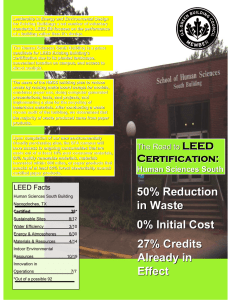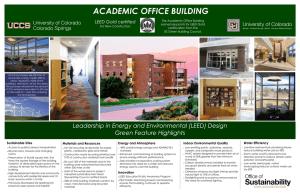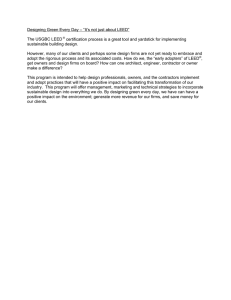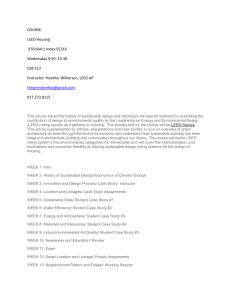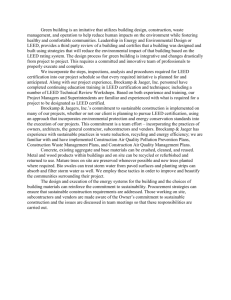Taconic Regional Offices Green Building Success LEED Building Renovation and Construction
advertisement
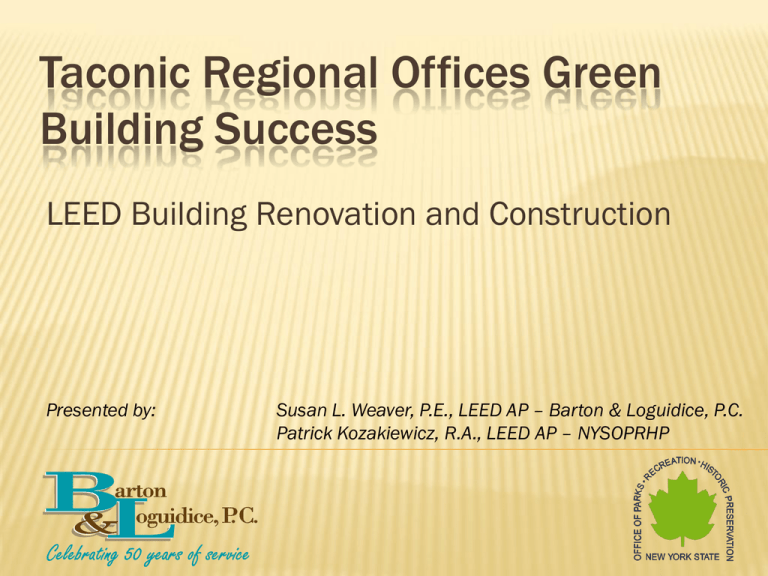
Taconic Regional Offices Green Building Success LEED Building Renovation and Construction Presented by: Susan L. Weaver, P.E., LEED AP – Barton & Loguidice, P.C. Patrick Kozakiewicz, R.A., LEED AP – NYSOPRHP The U.S. Green Building Council New York Upstate Chapter is a Registered Provider with The American Institute of Architects Continuing Education Systems (AIA/CES). Credit(s) earned on completion of this program will be reported to AIA/CES for AIA members. Certificates of Completion for both AIA members and non-AIA members are available upon request. This program is registered with AIA/CES for continuing professional education. As such, it does not include content that may be deemed or construed to be an approval or endorsement by the AIA of any material of construction or any method or manner of handling, using, distributing, or dealing in any material or product. Questions related to specific materials, methods, and services will be addressed at the conclusion of this presentation. Before After Before After Learning Objectives Taconic Regional Offices - Green Building Success /- NYSGBC36 / 2011 Description: Explore LEED design challenges, lessons learned, and energy performance, as well as occupant satisfaction for the building renovation of a former 1930s school transformed into the Taconic Regional Offices. Learning Units: 1 Credit Designations: LU|HSW|SD Learning Objectives Learning Objective 1: Integration of LEED design elements Learning Objective 2: Describe some of the issues and lessons learned during design and construction phase. Learning Objective 3: Investigate the actual energy performance of HVAC and electrical systems. Learning Objective 4: Determine the affect of LEED design elements on occupant satisfaction with working environment. Green Building Success Original Plan – LEED Silver Issues During Design/Construction “Lessons Learned” Energy Performance Occupant Satisfaction Original Plan Target LEED Silver Original LEED checklist Developed during design charrette Initial expectations SS (no heat island; light pollution red; alternate public transportation) E&A (14% energy performance; no enhanced refrigerant management or green power) IEQ (no increased vent; indoor pollution control; controllability-lights/HVAC; thermal comfort design) IDP (LEED Accredited Professional only) Sustainable Sites (SS) Alternative transportation Close to public transportation access Created bicycle storage and changing room Added outlet for electric vehicle and parking for fuel-efficient vehicles Reduced parking capacity by creating reinforced turf for overflow parking Sustainable Sites (SS) Site development Maximize open spaces Stormwater design Quantity control - created stormwater retention ponds and used permeable pavers Quality control – Pervious Pavement Interlocking pavers shown Water Efficiency Targeted all 5 points Water efficient landscaping Reduce by 50% No irrigation – used native plants Innovative Tertiary Water wastewater technologies treatment on site (septic system) use reduction 20% - low flow plumbing fixtures 30% - waterless urinals Energy and Atmosphere (EA) Optimize energy performance Targeted 14% better performance than typical model (all electric heat pumps) Vertical geothermal heat pump system DCV for auditorium make-up air unit Air-to-air energy recovery on make-up air units Geothermal water-to-water heat pump to supply heating/cooling coils on make-up air units Added insulation along perimeter walls and spray-on insulation in attic (R-15 batt and R-45 blown-in) Replaced windows (U-value of 0.3 versus .86 existing) Energy and Atmosphere (EA) Enhancing commissioning On-site renewable energy Geothermal system (did not use this as it does not meet the intent of the credit) Added photovoltaic system on auditorium roof Measurement and verification Photovoltaic System Panels on auditorium roof Materials and Resources (MR) Construction waste management Divert 50% from disposal Recycled content Rapidly renewable materials Certified wood Indoor Environmental Quality (IAQ) Outdoor air delivery monitoring Construction IAQ management plan During construction/before occupancy Low-emitting materials Daylight and views – 75% of spaces Controllability of lighting/HVAC Task lighting and small heat pumps Thermal comfort-design/verification Room temperatures/occupant surveys Typical Office Space Interior walls with windows for daylighting Innovation and Design Process (ID) LEED Accredited Professional Later added on four additional credits Green Building Success Original Plan – LEED Silver Issues During Design/Construction “Lessons Learned” Energy Performance Occupant Satisfaction Design Issues Mitigation of standing water on site Created stormwater retention ponds Created reinforced turf overflow parking Earned Stream Innovative Credit – maximize open space restoration – daylighting retention ponds to stream Earned Protect/Restore Habitat Credit Earned Innovative Credit – stream restoration Stream Design Issues Building vacant for 8 years Roof leaks into auditorium required more extensive renovations Structural repairs and replacements New roof (added photovoltaics) New floor (used cork floor) Damaged/leaking New windows energy efficient windows throughout SHPO was kept involved and informed throughout project Design Issues Historical nature of building (SHPO) Kept ceilings exposed Heat pumps located in attic or basement Coordination of trades (ductwork, sprinklers, lights, conduit all exposed) LED to spray-on insulation to ceiling of attic instead of floor to condition space for HPS New windows SHPO agreed to window replacement Found energy efficient windows with historic look Existing Hallway Upper floor hallway area Lessons Learned Standing water on site Extended schedule for site work Extensive dewatering required Used temporary retention ponds Lessons Don’t learned underestimate water issues on a flat site Geothermal well drilling creates water Anticipate required temporary measures Geothermal Well Drilling Example of site disturbance Lessons Learned LEED and historical nature of building Window replacements Exposed ceilings Integrated design Lessons learned Communication with interested parties essential Coordination of trades Exposed conduit, ductwork, sprinklers, lights Research and discuss design alternatives to fit LEED Changes during design easier with continued communication between trades Green Building Success Original Plan – LEED Silver Issues During Design/Construction “Lessons Learned” Energy Performance Occupant Satisfaction Energy Performance Building performance targeted for 14% then 21% improvement Achieved 54% performance improvement Modeled comparing geothermal with all electric heat pump system (per guidelines) Earned Innovative Design Credit Photovoltaic Currently system produces producing ~25 kWh per day Mechanical Room Geothermal pumps Energy Performance Annual building performance compared to similar buildings* 90 kBTU/SF per year for typical building 33 kBTU/SF per year for Taconic building Summer 0.63 Winter 0.87 average performance kWh/SF average performance kWh/SF *Source: US Department of Energy – Building Energy Use Intensities Comparison Green Building Success Original Plan – LEED Silver Issues During Design/Construction “Lessons Learned” Energy Performance Occupant Satisfaction Occupant Satisfaction Thermal comfort-verification Thermal Rating If comfort survey overall satisfaction Very satisfied Satisfied Somewhat satisfied Neutral Somewhat dissatisfied Dissatisfied Very dissatisfied dissatisfied - asked to indicate what contributes to dissatisfaction Occupant Satisfaction Thermal comfort survey results 84% of occupants rated space as neutral to very satisfied 16% of occupants rated space as dissatisfied Reasons for dissatisfaction - most in same area Air blowing on occupant Too cold – most complaints Too hot Conclusions Building transformed due to integrated design and cooperation Lessons learned Investigate existing conditions Work with other agencies closely Site disturbance for geothermal installation Coordination of trades Conclusions Energy performance can be achieved effectively with integrated design Occupant satisfaction evident using LEED design practices Taconic Regional Offices Main entrance Course Evaluations In order to maintain high-quality learning experiences, please access the evaluation for this course by logging into CES Discovery and clicking on the Course Evaluation link on the left side of the page. Thank You for Your Time! This concludes The American Institute of Architects Continuing Education System Program
